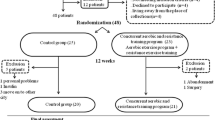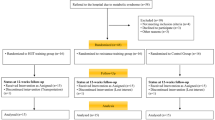Abstract
Purpose
The effects of exercise training on meteorin-like protein (METRNL), one of the newest factors involved, is one of the treatment strategies for diabetes. The present study aimed to investigate the effects of circuit resistance training on METRNL and insulin resistance in people with Type 2 Diabetes Mellitus (T2DM).
Methods
Twenty eligible diabetics volunteered to participate and were randomly divided into control (n = 10, age = 51 ± 1 years, BMI = 27.43 ± 0.98 kg/m2) and experimental groups (n = 10, age = 51 ± 1 years, BMI = 30.12 ± 0.92 kg/m2). The circuit resistance training (10 exercises) used in this study was performed for eight weeks (3 non-consecutive sessions/week, 2–4 circuits, 40%-80% 1RM, 15–6 repetitions). The rest period between each exercise was 20–30 s, and the rest between each circuit was 3 min. Participants in the control groups were asked to maintain their daily physical activities and not to engage in any systematic training program throughout the study.
Results
METRNL did not change significantly in the control group (0.66 ± 0.06 to 0.7 ± 0.04), but it increased significantly in the experimental group (0.3 ± 0.06 to 0.71 ± 0.03, p = 0.001); In contrast, FBS increased significantly in the control group (122.8 ± 7.5 to 192.8 ± 14.9) and decreased significantly in the experimental group (197.2 ± 7.1 to 135.00 ± 14.00, p = 0.001). Insulin in control and experimental groups did not change significantly (p = 0.96); However, the IR of the control group increased significantly (6.37 ± 1.46 to 9.6 ± 1.53), but its level was significantly attenuated in the experimental group (4.89 ± 1.37 to 4.38 ± 1.44, p = 0.028).
Conclusion
Eigth weeks of circuit resistance training with low to high intensities can increase the resting levels of METRNL in men with T2DM, which can be significantly associated with the improved fasting blood glucose levels and insulin resistance.



Similar content being viewed by others
References
Heng BH, et al. The Singapore National Healthcare Group Diabetes Registry–descriptive epidemiology of type 2 diabetes mellitus. Ann Acad Med Singap. 2010;39(5):348–52.
Indra, E.N., S. Sumaryanto, and C. Setiawan, Public Pedagogy of Healthy Living: A Thematic Analysis of Social Media Posts about Obesity, Physical Activity, and Diet. Ann Appl Sport Sci, 2023. 11(1): p. 0–0.
Soška V, et al. The logarithm of the triglyceride/HDL-cholesterol ratio is related to the history of cardiovascular disease in patients with familial hypercholesterolemia. Clin Biochem. 2012;45(1–2):96–100.
Teixeira-Lemos E, et al. Regular physical exercise training assists in preventing type 2 diabetes development: focus on its antioxidant and anti-inflammatory properties. Cardiovasc Diabetol. 2011;10(1):12.
Wilcox G. Insulin and insulin resistance. Clin Biochem Rev. 2005;26(2):19.
Hu G, et al. Exercise, genetics and prevention of type 2 diabetes. Essays Biochem. 2006;42:177–92.
Candrawati, S., et al., The Effect of UCP2 45bp Insersi/Delesi Genetic Variation on the Body Composition of Woman with Obesity in Continuous Training and High-Intensity Interval Training: A Randomized Controlled Trial Study. Ann Appl Sport Sci, 2022. 10(2): p. 0–0.
Cho J-K, Han T-K, Kang H-S. Combined effects of body mass index and cardio/respiratory fitness on serum vaspin concentrations in Korean young men. Eur J Appl Physiol. 2010;108(2):347.
Saeidi A, et al. Diabetes, Insulin Resistance, Fetuin-B and Exercise Training. Ann Appl Sport Sci. 2019;7(2):1–2.
Tayebi SM, et al. Exercise Training, Neuregulin 4 and Obesity. Ann Appl Sport Sci. 2017;5(2):1–2.
Zheng SL, et al. Metrnl: a secreted protein with new emerging functions. Acta Pharmacol Sin. 2016;37(5):571–9.
Chung HS, et al. Implications of circulating Meteorin-like (Metrnl) level in human subjects with type 2 diabetes. Diabetes Res Clin Pract. 2018;136:100–7.
Jung TW, et al. METRNL attenuates lipid-induced inflammation and insulin resistance via AMPK or PPARδ-dependent pathways in skeletal muscle of mice. Exp Mol Med. 2018;50(9):122.
Li Z-Y, et al. Adipocyte Metrnl antagonizes insulin resistance through PPARγ signaling. Diabetes. 2015;64(12):4011–22.
Lee JH, et al. Serum Meteorin-like protein levels decreased in patients newly diagnosed with type 2 diabetes. Diabetes Res Clin Pract. 2018;135:7–10.
Zhang YM, et al. Wogonin suppresses osteopontin expression in adipocytes by activating PPARα. Acta Pharmacol Sin. 2015;36(8):987–97.
Reasner CA, Göke B. Overcoming the barriers to effective glycaemic control for type 2 diabetes. The British Journal of Diabetes & Vascular Disease. 2002;2(4):290–5.
Frøsig C, Richter EA. Improved insulin sensitivity after exercise: focus on insulin signaling. Obesity. 2009;17(S3):S15–20.
AminiLari Z, et al. The effect of 12 weeks aerobic, resistance, and combined exercises on omentin-1 levels and insulin resistance among type 2 diabetic middle-aged women. Diabetes Metab J. 2017;41(3):205–12.
Alizadeh H, Safarzadeh A, Talebi-Garakani E. Effect of resistance training on serum meteorin-like hormone level and insulin resistance index in overweight adolescent boys. Journal of Arak University of Medical Sciences. 2017;20(7):54–64.
Bae JY. Aerobic Exercise Increases Meteorin-Like Protein in Muscle and Adipose Tissue of Chronic High-Fat Diet-Induced Obese Mice. Biomed Res Int. 2018;2018:6283932.
Eaton M, et al. Impact of a single bout of high-intensity interval exercise and short-term interval training on interleukin-6, FNDC5, and METRNL mRNA expression in human skeletal muscle. Journal of sport health science. 2018;7(2):191–6.
Rao RR, et al. Meteorin-like is a hormone that regulates immune-adipose interactions to increase beige fat thermogenesis. Cell. 2014;157(6):1279–91.
Saeidi A, et al. Effects of exercise training on type 2-diabetes: the role of Meteorin-like protein. Health Promot Perspect. 2019;9(2):89–91.
El-desoky G, Aboul-Soud M, Al-Numair K. Antidiabetic and hypolipidemic effects of Ceylon cinnamon (Cinnamomum verum) in alloxan-diabetic rats. Journal of medicinal plant research. 2012;6:1685–91.
Cho NH, et al. IDF Diabetes Atlas: Global estimates of diabetes prevalence for 2017 and projections for 2045. Diabetes Res Clin Pract. 2018;138:271–81.
Khajehlandi, M., et al., Endurance Training Regulates Expression of Some Angiogenesis-Related Genes in Cardiac Tissue of Experimentally Induced Diabetic Rats. Biomolecules, 2021. 11.
Lee, J.O., et al., The myokine meteorin‐like (metrnl) improves glucose tolerance in both skeletal muscle cells and mice by targeting AMPKα2. The FEBS Journal, 2020.
Tayebi SM, Saeidi A, Khosravi M. Single and Concurrent Effects of Endurance and Resistance Training on Plasma Visfatin, Insulin, Glucose and Insulin Resistance of Non-Athlete Men with Obesity. Ann Appl Sport Sci. 2016;4(4):21–31.
Karimi, M., The effect of aerobic exercise on serum levels of methorine-like hormone (metrenol) in obese women, in the first international conference and the third national conference on new research in sports science. 2019, Mohaghegh Ardabili University: Ardabil, Iran.
Dunstan DW, et al. High-intensity resistance training improves glycemic control in older patients with type 2 diabetes. Diabetes Care. 2002;25(10):1729–36.
AfshounPour MT, et al. The Effect of Circuit Resistance Exercise On Plasma Resistin Concentration and Insulin Resistance in Type 2 Diabetic Men. Journal of Shahid Sadoughi University of Medical Sciences. 2015;23(8):770–81.
Ghanbari-Niaki A, et al. Influence of resistance training and herbal supplementation on plasma apelin and metabolic syndrome risk factors in postmenopausal women. Sci Sports. 2020;35(2):109.e1-109.e5.
de Sousa RAL, et al. Moderate/high resistance exercise is better to reduce blood glucose and blood pressure in middle-aged diabetic subjects. Revista Brasileira de Educação Física e Esporte. 2020;34(1):165–75.
Chiang SL, et al. Effects of a 12-week moderate-intensity exercise training on blood glucose response in patients with type 2 diabetes: A prospective longitudinal study. Medicine (Baltimore). 2019;98(36): e16860.
Jiang Y, et al. Aerobic exercise training at maximal fat oxidation intensity improves body composition, glycemic control, and physical capacity in older people with type 2 diabetes. J Exerc Sci Fit. 2020;18(1):7–13.
Thomas, D., E.J. Elliott, and G.A.J.C.d.o.s.r. Naughton, Exercise for type 2 diabetes mellitus. Cochrane database of systematic reviews, 2006(3).
Azari N, Rahmati M, Fathi M. The effect of resistance exercise on blood glucose, insulin and insulin resistance in Iranian patients with type II diabetes: A systematic review and meta-analysis. Iranian Journal of Diabetes and Obesity. 2018;10(1):50–60.
Saravani, M., et al., Effect of a Circular Resistance Training Course on Serum levels of Chemerin, Glucose and Insulin Resistance in Overweight and obese Disabled Men. Asian Exercise and Sport Science Journal, 2020. 4(1).
Liu Y, et al. Resistance exercise intensity is correlated with attenuation of HbA1c and insulin in patients with type 2 diabetes: a systematic review and meta-analysis. Int J Environ Res Public Health. 2019;16(1):140.
HASKELL, W.L., The influence of exercise training on plasma lipids and lipoproteins in health and disease. Acta Medica Scandinavica, 1986. 220(S711): p. 25–37.
Moholdt TT, et al. Aerobic interval training versus continuous moderate exercise after coronary artery bypass surgery: a randomized study of cardiovascular effects and quality of life. Am Heart J. 2009;158(6):1031–7.
Safarzade, A., H. Alizadeh, and Z. Bastani, The effects of circuit resistance training on plasma progranulin level, insulin resistance and body composition in obese men. Horm Mol Biol Clin Investig, 2020. 41(2).
Hur S, et al. Effect of Resistance Exercise on Serum Osteoprotegerin Levels and Insulin Resistance in Middle-Aged Women with Metabolic Syndrome. Medical science monitor : international medical journal of experimental and clinical research. 2018;24:9385–91.
Author information
Authors and Affiliations
Corresponding author
Ethics declarations
Conflict of Interest
On behalf of all authors, the corresponding author states that there is no conflict of interest.
Additional information
Publisher's Note
Springer Nature remains neutral with regard to jurisdictional claims in published maps and institutional affiliations.
Rights and permissions
Springer Nature or its licensor (e.g. a society or other partner) holds exclusive rights to this article under a publishing agreement with the author(s) or other rightsholder(s); author self-archiving of the accepted manuscript version of this article is solely governed by the terms of such publishing agreement and applicable law.
About this article
Cite this article
Tayebi, S.M., Golmohammadi, M., Eslami, R. et al. The Effects of Eight Weeks of Circuit Resistance Training on Serum METRNL Levels and Insulin Resistance in Individuals with Type 2 Diabetes. J Diabetes Metab Disord 22, 1151–1158 (2023). https://doi.org/10.1007/s40200-023-01225-1
Received:
Accepted:
Published:
Issue Date:
DOI: https://doi.org/10.1007/s40200-023-01225-1




